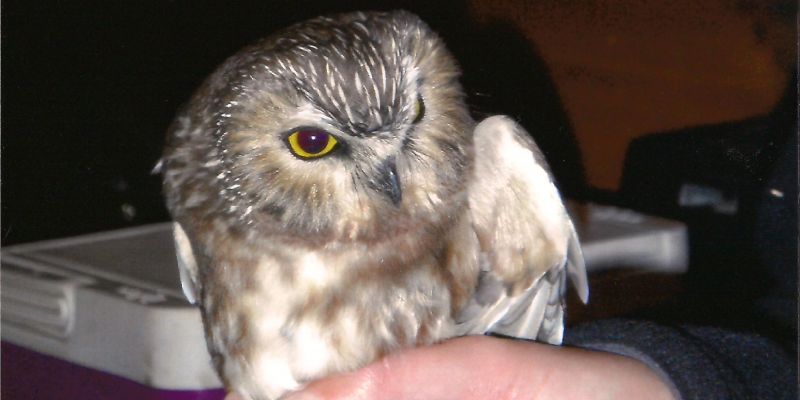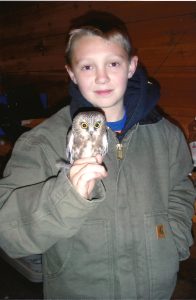
One crisp autumn evening in 2011, I was one of the fortunate few to take part in a unique experience. My family and I had the privilege to observe a study involving the Northern Saw-whet owl. What, you may ask, is a Saw-whet owl?
A Saw-whet owl stands approximately 17 to 21 centimeters tall [5.5 to 8.5 inches] and weighs around 75 to 100 grams [2.5 to 3.5 ounces]. Their average life span is about four years, but they are known to reach eight years. It makes sense that they have such a short life span taking the challenges of their daily life into consideration. Saw-whets contend with predators, weather, food shortages and long migrations. They begin their long journey in Canada and travel south along the Appalachian Mountains to as far south as Alabama.
A research study is currently being conducted by Dr. Glenn Proudfoot, Biologist at Vassar College. In 2011, when I first met Dr. Proudfoot, he was involved in the fifth year of his Saw-whet owl study. He is compiling data regarding the weight, age, sex and stress levels of these owls as they migrate through the Hudson Valley. My family and I were merely along for the ride. We were invited on this wonderful journey by a co-worker of my stepfather, biology teacher Christine Guerrino. At the time, I was twelve and I can assure you it was an experience I will always remember. We were instructed to meet Dr. Proudfoot and his assistant Christine on Mohonk Preserve property. It was a mid-October evening at approximately 7pm when we arrived.

Jonathan Newkirk, with a Saw-whet Owl.
As soon as I stepped out of our truck I began to hear what sounded like a truck backing up in the woods. Later I learned that this “beep-beep-beep” sound was the territorial call of Saw-whet owls played through an MP3 player. The MP3 player was attached to a set of speakers placed strategically in the woods. A series of soft, fine-mesh nets was located near the MP3 player. This call attracts the migrating Saw-whet owls and they fly into the nets. Dr. Proudfoot and his assistant, Ms. Guerrino, delicately remove the owls from the nets unharmed. The owls are then taken indoors where they are weighed, measured and banded. Scientific data is gathered for research purposes and Dr. Proudfoot keeps meticulous records regarding this data. The owls are banded as an identifier of previous capture, as well as to track their migration. During the entire time frame in captivity the owls are gently handled in a warm environment. They are then released back into the night without injury.
From this experience I learned how small and docile Saw-whet owls can be. Considering they are creatures of the wild, I was amazed at how calm they were with close human contact. I am proud to say that I have observed two seasons of owl banding. The owls are not harmed in any manner and they truly seem to enjoy Dr. Proudfoot’s soothing touch as he collects the scientific data. I look forward to hopefully being invited on this adventure again as it was a very great privilege and honor to be allowed to participate. For more information on Dr. Glenn Proudfoot and his Saw-whet Owl study, please visit http://www.bioone.org/doi/abs/10.1676/10-130.1
Editor’s note: For information about Mohonk’s programs visit www.mohonkpreserve.com or call the Preserve at 845 255-0919.
